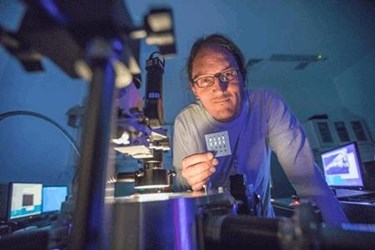AMBER Researchers Make Low-Cost Printed Electronics From 2D Nanomaterials
By Jof Enriquez,
Follow me on Twitter @jofenriq

Researchers at AMBER (Advanced Materials and BioEngineering Research) center in Trinity College Dublin are the first to successfully print nanosheet-network transistors using two-dimensional (2D) materials, paving the path for inexpensive printed electronics used in everyday objects.
The 2D material graphene has exceptional electrical and thermal conductivities, but poor semiconductor properties, and it is often paired with other 2D nanomaterials to achieve electronic applications that could supplant silicon-based devices. AMBER’s research project has combined these 2D nanomaterials, resulting in a breakthrough for printable electronics.
The team, led by Prof. Jonathan Coleman, an investigator in AMBER and Trinity’s School of Physics, developed a fabrication method combining the 2D nanomaterials graphene (electrode), tungsten diselenide (channel), and boron nitride (separator) into an all-printed, all-nanosheet, working transistor.
“Electronics has been around for donkey’s years and Intel out in Leixlip are among those making high-end, high performing transistors. However, unlike them we are trying to make transistors so cheaply that they could be used in pretty much anything,” Coleman told The Irish Times.
“We were able to print the initial transistors from a standard inkjet printer...we now intend to try to make more sophisticated printed transistors,” he added.
While printable electronics have been produced for several years, carbon-based materials used in most printable electronics are "unstable" and have "well-known performance limitations," according to the researchers. Even alternative materials, such as carbon nanotubes or inorganic nanoparticles used in state-of-the-art printed electronics, still present some challenges to manufacture.
Coleman believes his method of liquid processing is better at producing large quantities of the high-quality 2D materials that are easily processed into inks used to cheaply print low-cost circuits. Because it is cheaper to produce, the technology can be applied in a range of common products and objects, from smart food and drug labels to banknotes and e-passports, to name just a few.
“Printed electronic circuitry (constructed from the devices we have created) will allow consumer products to gather, process, display, and transmit information: for example, milk cartons could send messages to your phone warning that the milk is about to go out-of-date,” said Coleman in a news release.
The research study, All-printed thin-film transistors from networks of liquid-exfoliated nanosheets, is published in the April 7 edition of the journal Science.
“This publication is important because it shows that conducting, semiconducting and insulating 2D nanomaterials can be combined together in complex devices. We felt that it was critically important to focus on printing transistors as they are the electric switches at the heart of modern computing. We believe this work opens the way to print a whole host of devices solely from 2D nanosheets,” said Coleman.
